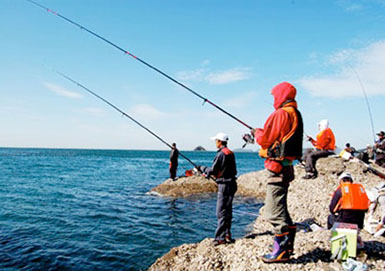Learn Tagalog with these resources
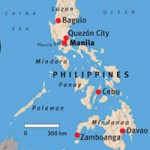 Tagalog is the lingua franca of the Philippines and the fourth most spoken language in the US, behind English, Spanish and “Chinese Languages” (mostly Cantonese, some Mandarin). It’s a fascinating language with plenty of speakers (~25 million) and not so many resources. I’ve looked far and wide for vocabulary books or good word lists, and unfortunately, I can’t seem to find any. But that’s OK. There’s certainly enough out there to get the job done.
Tagalog is the lingua franca of the Philippines and the fourth most spoken language in the US, behind English, Spanish and “Chinese Languages” (mostly Cantonese, some Mandarin). It’s a fascinating language with plenty of speakers (~25 million) and not so many resources. I’ve looked far and wide for vocabulary books or good word lists, and unfortunately, I can’t seem to find any. But that’s OK. There’s certainly enough out there to get the job done.
Tagalog, Filipino and Pilipino
The very first thing you’ll need to do is to wrap your head around the whole Tagalog/Filipino/Pilipino thing. Language is often a symbol of national and cultural identity, and the people of the Philippines have gone through rough times in terms of maintaining their national identity (or indeed, of even having a “national” identity; the Philippine Archipelago was a group of totally independent kingdoms before Spanish explorers came in and took over). After hundreds of years of colonization, the Filipino people understandably wanted a national language. But this proved difficult, since there are 120-175 languages spoken within the Philippine Archipelago, many of which are related, but only barely.
Here’s the Philippine national proverb, “He who does not (know how to) look back at his past (where he came from) will not reach his destination,” translated into Tagalog and Cebuano, the two languages with the largest number of speakers:
Tagalog (22 million native speakers): Ang hindi marunong lumingon sa pinanggalingan ay hindi makararating sa paroroonan.
Cebuano (20 million native speakers): Kadtong dili kahibalo molingi sa iyang ginikanan, dili makaabot sa iyang gipadulongan.
Once upon a time, these two languages were referred to as “dialects” of the same language. But they’re ‘dialects’ in the same way that French and Spanish are ‘dialects’ of Latin – perhaps even less so. Nonetheless, the Filipino people wanted a single, national language, and so, in 1987, “Filipino” became the official national language of the Philippines. It’s basically Tagalog, with some words from neighboring languages added in. Most of the Philippine population speaks it, at least as a second language. For the purposes of language learning, you can pretty much assume that Filipino and Tagalog are the same.
Where does “Pilipino” fit in? That’s perhaps the simplest part of the story. Filipino has no native “F” consonant, so if you ask how to pronounce “Filipino,” you’ll hear “Pilipino.” If you’re interested in reading more about this whole (kind of confusing) topic, try this article at Tagaloglang.com.
Incidentally, if you’re not quite sure how to pronounce “Tagalog,” it’s [təˈɡɑːlɑɡ] (tuh-GAH-log) in English, and [ta'ga:'log] in Tagalog. Today is definitely the first day I’ve pronounced it correctly. ![]()
A Plan of Action
For the other languages on this site (except for Thai), I’ve stuck to a fairly basic plan that walks you through pronunciation, vocabulary, and grammar, then leads you to a few resources for listening and reading. I’m going to change that plan a bit here, in part because Tagalog doesn’t have a lot of the resources I usually like to recommend, and in part because my general plan for learning languages has changed somewhat over the course of writing my book, and I haven’t gotten around to completely rewriting the rest of the site. So you’ll see some information here first. Yay.

The new plan (for any language) looks like this:
- Learn pronunciation first
- Learn to recognize any new sounds (Article coming soon! You’ll use minimal pairs.)
- Learn to make those sounds
- Learn the spelling system of the language.
- Learn 625 basic words using pictures and without translations (Note: the site’s basic word list is only 400 words long; I’ll have the rest up soon!)
- Open your grammar book and learn the basics of grammar. Get around half-way through
- Pull out a frequency list and get cracking on the top 1000-2000 words in your language.
- Start writing on Lang-8.com, and turn all of your corrections into flashcards with pictures.
- Now go explore. Read the rest of your grammar book, read a real book with an audiobook, start watching TV (without subtitles) and talking to native speakers.
For Tagalog, the only real change is in step 4, since there doesn’t seem to be any frequency list in this language, not even a crappy one from Wikipedia. [Note: I see reference to a frequency dictionary in Tagalog, but it's almost impossible to find, and it's not clear whether it's a bilingual or monolingual dictionary. If you find it or find out more information, let me know.] Given the lack of a frequency dictionary, you’ll need to jump to steps 5 and 6 a little earlier than I’d usually prefer. Still, since there are some pretty good grammar books in this language, you should be fine.
Let’s get started.
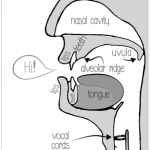 Learn Tagalog Pronunciation
Learn Tagalog Pronunciation
I don’t think you’ll ever meet a friendlier language, phonetically speaking. The sounds are simple, the spellings are simple, and the alphabet is the familiar, English alphabet. Here are some English-Tagalog cognates:
English: Automobile –– Tagalog: Awtomobil
English: Economics –– Tagalog: Ekonomiks
English: Website –– Tagalog: Websayt
I mean…seriously. It just doesn’t get any easier than that.
You have a small handful of new sounds, and I’ll link you to video discussions of each one. If you haven’t seen my video series on pronunciation, you might want to do that first:
- R-tap (an R, made like a really fast D)
- Palatal N (an N made with the middle of the tongue)
- A dental D (you make the D with the tip of your tongue against your teeth instead of behind them)
- K’s are basically Ks, but they’re made a little further back in the throat than in English
- T’s, P’s and K’s are all unaspirated, so there’s no puff of air coming out when you say them (The T is like “My cat Stan” as opposed to “My cat’s tan”
- The glottal stop is more important in Tagalog than in English. I’ll try to find recordings of word pairs that demonstrate this. A few key word pairs would be bata’ (child) and bata (bathrobe), kaon (fetch) and kahon (box) and mag-alis (remove) and magalis (full of sores).
- You’ll probably want a raspy “ch” sound (the velar fricative, x) for words like
- And occasionally, you might run into a velar approximant, which is basically a “Y” that you make with the back of your tongue instead of the middle of your tongue. It’s pretty rare, though.
In terms of vowels, you’ll have a pretty easy time. There are basically only 5 vowels: a, e, i, o, u. You’ll need to get rid of your English diphthongs for “o” and “e” (we don’t really say “o”; we go “oh-uu”), and you’ll need a brighter “a.” I talk about all three of these things in the French vowel video, so just watch that and ignore the blabbering about nasal vowels, since you don’t need those.
That’s it. Compared to most other languages, this is a piece of cake.
Learn the alphabet using example words and pictures. You can find a nice list at Wikipedia.
Base Vocabulary
 Learn your first 625 words using my base vocabulary list. To do that, you’ll want a Lonely Planet guide, so get that. Alternatively, if there’s enough interest, I’ll get a professional translation of the list and sell it here for $4. Let me know if you or someone you know might be interested, and if enough people contact me, I’ll make it.
Learn your first 625 words using my base vocabulary list. To do that, you’ll want a Lonely Planet guide, so get that. Alternatively, if there’s enough interest, I’ll get a professional translation of the list and sell it here for $4. Let me know if you or someone you know might be interested, and if enough people contact me, I’ll make it.
Usually, I’d suggest you learn the grammatical genders of all of your words at this point, but since Tagalog doesn’t use grammatical gender, you’re safe.
Grammar Time
Once you have your words down, you’re going to be pretty comfortable with the sound/spelling system in Tagalog, and you’ll be in a great place to start mastering grammar. Read my article about learning grammar without translation, then use those techniques to grab example sentences from your grammar book for every rule.
 There are two main grammar books I’d recommend. Grab one of them.
There are two main grammar books I’d recommend. Grab one of them.
If you’re a beginner, and if this is your first language, I’d suggest Basic Tagalog for Foreigners and Non-Tagalogs. It has pretty clear explanations, lots of examples (with translations), and an audio CD, making it a comfortable introduction to the language.
 If you’re a little more advanced, or if you like a denser, more comprehensive sort of book, then consider Essential Tagalog Grammar. It’s a pretty neat book, and it goes into a bit more depth than the Basic Tagalog book.
If you’re a little more advanced, or if you like a denser, more comprehensive sort of book, then consider Essential Tagalog Grammar. It’s a pretty neat book, and it goes into a bit more depth than the Basic Tagalog book.
(And if you’re really more advanced, then check out this post on Reddit, which has some more recommendations for advanced learners)
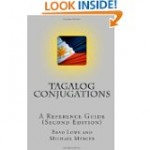 The last grammar-type book I’d recommend is a supplemental book dedicated exclusively to the prefixes, suffixes and infixes of Tagalog, which are used to do all sorts of things, like conjugate verbs. Tagalog has a lot of these things, and this book provides example sentences of each and every one of them. I’ve linked the new 2nd edition, but check out the reviews of the first edition to see how much people flip out over this book. Get it (it’s pretty cheap).
The last grammar-type book I’d recommend is a supplemental book dedicated exclusively to the prefixes, suffixes and infixes of Tagalog, which are used to do all sorts of things, like conjugate verbs. Tagalog has a lot of these things, and this book provides example sentences of each and every one of them. I’ve linked the new 2nd edition, but check out the reviews of the first edition to see how much people flip out over this book. Get it (it’s pretty cheap).
Note: If you’ve never heard of an infix before, you’re not alone. I certainly didn’t know about them until encountering Tagalog. Infixes are just like prefixes (rerun, redo, rewrite) and suffixes (information, emancipation, salvation), but they go in the middle of a word. So to conjugate the Tagalog loan word “graduate,” you have to add the infix “um”: grumaduate (I graduate). Awesome.
As I mentioned above, I’d usually suggest that you move on to a frequency list once you’ve gone through half of your grammar book. But since there’s no such thing in Tagalog, you’ll need to cultivate your own sense for which words are important and which words aren’t. If you encounter a Tagalog version of “He gave her a container of raspberries,” then you’re definitely going to want to grab functional words, like “a” and “of,” basic verbs like “gave,” pronouns like “he” and “her,” and maybe even some everyday, commonly-used nouns, like “container.” But raspberries might not be particularly important to you, and you’re probably not going to encounter that many Tagalog raspberries in your future. So you probably don’t need a separate pair of flashcards for them (although if you’re a huge fan of raspberries and you want to be able to ask for them in a supermarket, then by all means, make a flashcard for them). Use your own judgement; in general, if you want a word to be an active part of your vocabulary, then make a couple of flashcards for it. If it’s fine for that word to be passive, then don’t bother.
Supplement your grammar book’s sentences by searching for interesting words in Google Images and creating word chains. This will expand your vocabulary and expose you to lots of new sentences, and new contexts for the grammar you’ve learned.
You can also check out Kalyespeak.com - it’s a lovely source of recorded, translated, entertaining conversations. They haven’t been updated in a long time, but you can go through their archives for a free textbook of really good examples. Think of it as a mini, free Assimil course.
Start Writing
You’re getting a lot of input from your grammar book and Google Images, but you’ll need to produce some language of your own in order to turn that input into a functional language. Writing is the simplest way to do this. Write regularly, using the content from your grammar book as a model. If your grammar book discusses introductions, introduce yourself in writing. If your grammar book discusses the past tense, then write about an old story.
Submit everything you write to Lang-8.com. Their native Tagalog community is relatively small, but there are even fewer Tagalog learners, so you shouldn’t have much trouble getting corrections, as long as you do a few corrections in your native language as well. Make sure you find 5-10 native speakers and add them to your friends list, so they see your entries first. Once you have your corrections, add them to your Anki deck as fill-in-the-blank exercises with pictures.
Explore
At this stage, you’ve gotten the basics of grammar and you’ve built a decent vocabulary. Now you can start to stretch out and explore the landscape:
Reading
This is usually where I try to read my first book while listening to an audiobook. It’s a nice way to get a lot of input at once, and begin to get a feel for the rhythm of the spoken language. My standard pick for a book is a translation of Harry Potter, but I can’t seem to find any copies for sale. If you have better luck, let me know. For now, I’ll send you a link to Amazon US’s modest Tagalog fiction section, Goodreads’ Tagalog recommendations, and Project Gutenberg’s public domain books section. As soon as I find a good source of Tagalog audiobooks, I’ll let you know (and if you find some, let me know, and I’ll post them here). There are a couple of free, public domain audiobooks in Tagalog, but aside from that, I’m not having much luck.
Listening
Ah, the first place where Tagalog actually has some good resources, and they’re free! Check out the GMA Network - a YouTube channel with around 500 free episodes of Filipino TV shows and news broadcasts. Awesome. Watching TV without subtitles is the best way to develop listening comprehension, and TV series. If they’re a bit daunting, search for one of their titles on Wikipedia and read about the show in Tagalog before you watch it. That way, you’ll already know much of the vocabulary, the character names and the basic outline of the plot. You’ll have an easier time when you finally watch it.
Speaking
Outside of the Philippines, your best bet for speaking practice is either a language exchange or a tutor on iTalki.com. If you work with a tutor, never switch to English, particularly whenever you run into a word you’re missing. Instead, find a way to say what you want to say (or ask for the word you need) entirely in Tagalog. Every time you do, you’ll take a step towards fluency. Tutors on iTalki are quite affordable ($3-8/hour for an untrained tutor, ~$6-9 for a professional teacher) and you’ll get twice as much speaking practice compared with an exchange, since you’ll be spending all of your time speaking Tagalog.
Other Resources
Bilingual dictionaries

There are two awesome print dictionaries for Tagalog. One is the little Carl Rubino dictionary, which is supposed to be pretty great for a little dictionary (and contains a lovely pronunciation discussion, though so do your grammar book options).
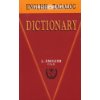
If you really want a beast of a book, get the Leo James dictionary. To quote an Amazon review, it’s “hands down this is the best Tagalog dictionary available. For each root word it gives all the different uses, the accent marks, different example sentences, and synonyms” I love dictionaries like this, because you can basically just read them like a book, find good example sentences, and dump them into your flashcards
In terms of online resources, the best I’ve seen is at Bansa.org
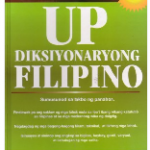 Monolingual Dictionaries
Monolingual Dictionaries
You’ll want to graduate to a monolingual dictionary as soon as you can, because monolingual dictionaries make much more efficient use of your time; every time you look up a word, you’ll passively pick up an extra 2-3 new words. But there’s a problem: the main monolingual dictionary you’ll need is unfortunately extremely difficult to get. The UP Diksiyonaryong Filipino is the only real option you have, and I still don’t know how to get it outside of the Philippines. If you find a good source, let me know and I’ll add it here. You can try Wiktionary, but it’s still fairly small (10k-100k entries). I’ve read some rumors about the UP Diksiyonaryong Filipino moving to the web, but that hasn’t happened yet. For now, build up your language using the available resources, and if you really start hitting a high-intermediate/advanced level, then you’ll be in a better place than I to inquire about how to get a physical copy of a monolingual dictionary. (Then tell me how you did it!)
